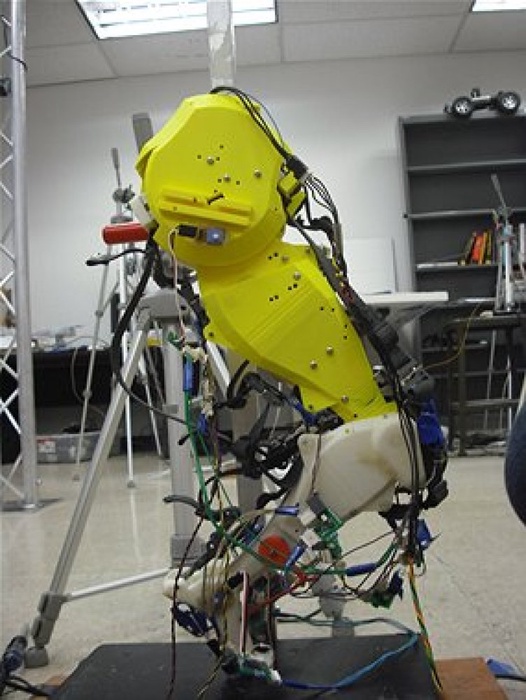
Scientists in the United States say they have made the world's most advanced pair of biomechanical legs, bringing the goal of human-friendly household robots a bit closer, AFP reports. About half the size of their human counterparts, the legs are the first to mimic walking in a biologically accurate, energy-efficient manner, say the researchers. They have the slight up-and-down movement of human legs, using load sensors in the feet that help a small computer adjust the motion according to the surface. "One of the ideas is that we build what I call soft robots, which can be used around human beings," said Anthony Lewis, who worked on the invention with Theresa Klein, both of the Department of Electrical and Computer Engineering at the University of Arizona. "In this robot, if you push against the legs, they'll give away freely, they won't resist you. "But conventional robots derive their heritage from industrial robots and they are very stiff -- they wouldn't be safe around grandma. So this is a step in that direction." The research appears on Friday in a peer-reviewed publication, the Journal of Neural Engineering. The sensors are one component in a triple system that aims at imitating the human gait, which has been honed by millions of years of evolution to be as smooth and energy-efficient as our anatomy will allow. The "skeleton" of the legs copies the three joints in the lower anatomy -- the hips, knees and ankles -- and the muscles are straps, which move up and down as actuators. The actual movements are determined by an electronic imitation of the central pattern generator (CPG), a neural network in the lower region of the spine that is semi-autonomous from the brain. The CPG generates rhythmic muscle signals after gathering information from various parts of the body that respond to the environment. This explains why we can walk without having to think about it. "We combined the three elements, the biomechanics and a complex central pattern generator with sensory feedback," Lewis said in an interview with AFP. "When we put all three together, the resultant movement was very much like a human being's and we know that because we saw a very good agreement with what we saw in human studies, particularly in the movement of the robot at the hip and knee." The next phase will be to incorporate vision to control gait as well as other tactile sensors, "so that if you stumble, the system will correct itself and not fall over," said Lewis. The legs are intended for fundamental research into understanding how humans learn to walk, but there could one day be gains for doctors trying to recover walking ability for patients with spinal-cord injuries, the researchers hope. In robotics, "two major corporations in the US have expressed interest in this work, and we are currently looking at transferring this technology to one of them," said Lewis.





Scientists in the United States say they have made the world's most advanced pair of biomechanical legs, bringing the goal of human-friendly household robots a bit closer, AFP reports.
About half the size of their human counterparts, the legs are the first to mimic walking in a biologically accurate, energy-efficient manner, say the researchers.
They have the slight up-and-down movement of human legs, using load sensors in the feet that help a small computer adjust the motion according to the surface.
"One of the ideas is that we build what I call soft robots, which can be used around human beings," said Anthony Lewis, who worked on the invention with Theresa Klein, both of the Department of Electrical and Computer Engineering at the University of Arizona.
"In this robot, if you push against the legs, they'll give away freely, they won't resist you.
"But conventional robots derive their heritage from industrial robots and they are very stiff -- they wouldn't be safe around grandma. So this is a step in that direction."
The research appears on Friday in a peer-reviewed publication, the Journal of Neural Engineering.
The sensors are one component in a triple system that aims at imitating the human gait, which has been honed by millions of years of evolution to be as smooth and energy-efficient as our anatomy will allow.
The "skeleton" of the legs copies the three joints in the lower anatomy -- the hips, knees and ankles -- and the muscles are straps, which move up and down as actuators.
The actual movements are determined by an electronic imitation of the central pattern generator (CPG), a neural network in the lower region of the spine that is semi-autonomous from the brain.
The CPG generates rhythmic muscle signals after gathering information from various parts of the body that respond to the environment. This explains why we can walk without having to think about it.
"We combined the three elements, the biomechanics and a complex central pattern generator with sensory feedback," Lewis said in an interview with AFP.
"When we put all three together, the resultant movement was very much like a human being's and we know that because we saw a very good agreement with what we saw in human studies, particularly in the movement of the robot at the hip and knee."
The next phase will be to incorporate vision to control gait as well as other tactile sensors, "so that if you stumble, the system will correct itself and not fall over," said Lewis.
The legs are intended for fundamental research into understanding how humans learn to walk, but there could one day be gains for doctors trying to recover walking ability for patients with spinal-cord injuries, the researchers hope.
In robotics, "two major corporations in the US have expressed interest in this work, and we are currently looking at transferring this technology to one of them," said Lewis.


 +7 (777) 001 44 99
+7 (777) 001 44 99















































